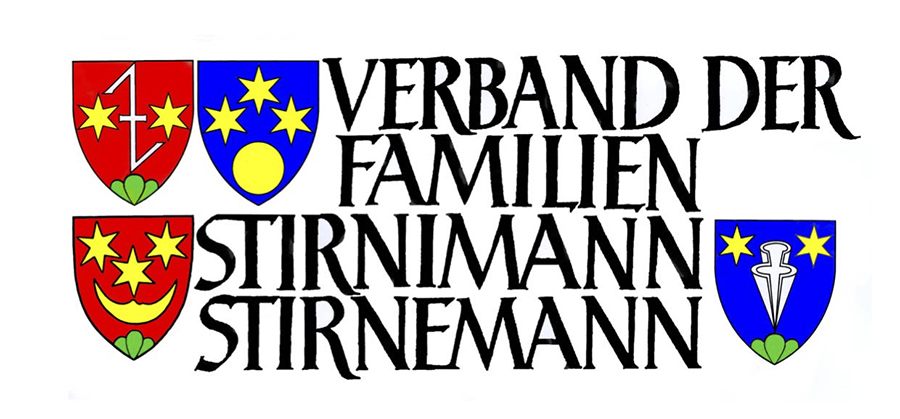

Table of Contents
Greeting 1
Coat of Arms 2 – 7
"Leidhelgeli" / Board of Directors 8
Dear relatives and friends,
dear members and friends
our family association
The Board of Directors of the Association of Families Stirnimann-Stirnemann wishes you all that "it's good chunnt". What more could you want? Health, contentment, prosperity in all concerns and joy in life and with the people.
Who would have thought that the plague would keep us busy all year round? Not me! I also did not think that the vaccination would trigger such heated discussions as it raised the question about the right belief. I would have also not expected that the decision by the other threatens the respect to be lost. Yet respect is a constituent element of our society: I don't agree with you, but I respect you as a human. So I wish you the serenity too, to have that respect that brings people closer to each other.
Corona brought a lot of confusion to the association board: We have perforce plans put back, a small association meeting, that was intended, but was not pursued further.
Board meetings were held twice via the Internet platforms. The situation in October then allowed that at the beginning of November we have met in regular session. Our most important decisions were the definition of the next association meeting on the September 8, 2024, which is also our 50th anniversary. Then the reason we have an interim revision of our Invoice, which we will then issue in 2024, as well as the appointment of two deserving members to the status of honorary members. Who have done 16 and 28 years of important work on the board, and have earned a place in the Association Hall of Honor. We thank Franz Stirnimann-Bühlmann, Lucerne, who has been our newsletter supervisor for many years and was on the board a total of 28 years. We continue to honor Mrs. Agnes Bensegger-Stirnimann, for her 16 years service of as actuary. Thanks very much!
I dedicate this newsletter to the Coats of Arms different branches. Who knows maybe other variants emerge from your circles on! I look forward to your reactions and wish you an entertaining reading.
Yours, Moritz Stirnimann, President
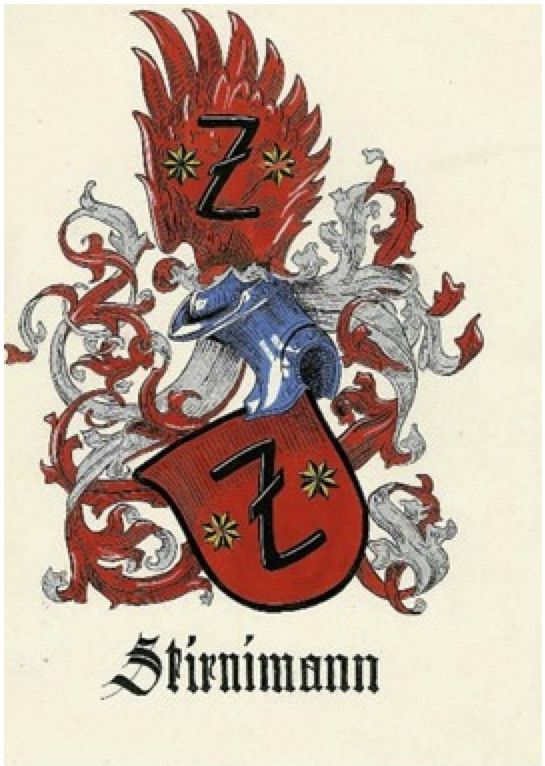
The coat of arms of the Stirnemann-Stirnimann family
The first circular from 1974 bears three coats of arms and a seal in the letterhead: the coat of arms of Stirnimann from Ruswil (1673, center), the coat of arms of Stirnimann from Surental (1884, left) and the coat of arms of Stirnemann from Gränichen (1660, right) symbolize the three main branches of the family. The small black and white depiction shows the seal of the Stirnimann from Ruswil from the year 1700 (discussed in circular 26).
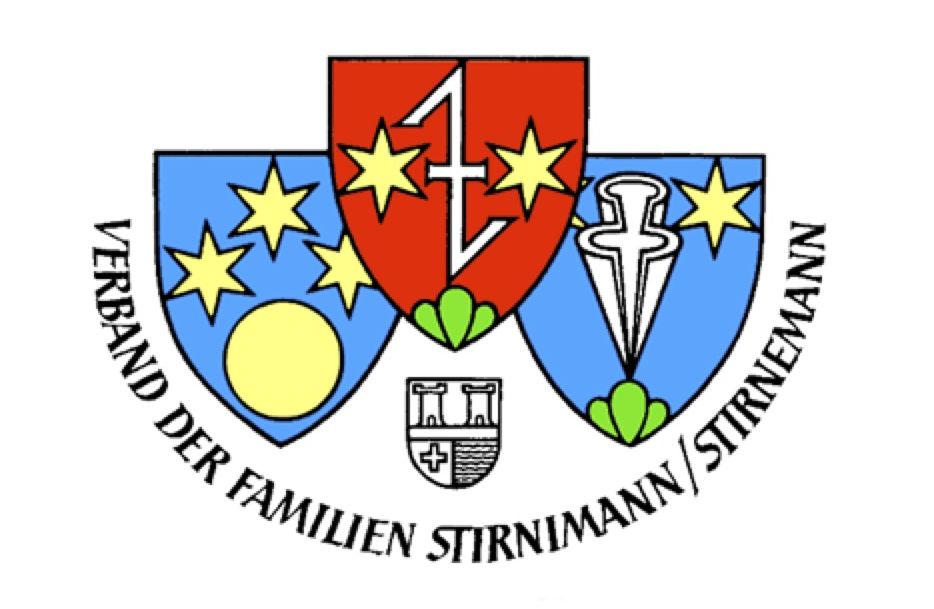
These coats of arms have been the coats of arms of the association of the Stirnimann-Stirnemann families since 1974. In recent years, however, family crests that deviate from these have also been shown on individual documents that have been handed over to us. Apparently there are individual deviating variants. Since the 2000 edition, you will find four coats of arms shown on the newsletter, two of Stirnemann and two of Stirnimann. The seal is missing; it was replaced by the red coat of arms of Stirnemann from Suhr, probably the oldest coat of arms in the family.
Since coats of arms can be registered in Switzerland but are not protected, I researched variants in the state archives of Aarau and Lucerne. I am now in possession of around twelve Stirnimann and seven Stirnemann coat of arms variants.
Meaning and Symbolism
If we look at the coat of arms of the family, certain illustrations are repeated in different combinations and variations: the house brand, moon and stars (constellations) and the so-called Dreiberg (tripple mountains rising from the bottom).
Professor Stirnimann described the house mark in his depiction of the three family coats of arms as a simple sign, often rune-like, with which possessions, houses, stables and equipment were marked in the past. House brands are widespread in rural societies.
The heraldist Rolf Kälin interprets the Dreiberg as a sign of connection with agricultural conditions, often simply denoting rural families. He relates the interpretation that the Dreiberg points to earlier, current, land ownership, etc. – That may be so, but our ancestors were really farmers, some even important landowners. This is indicated by the Dreiberg. The ancestral farms of the Stirnimann family are known and descendants of the founders of the coat of arms, relatives of ours, still live on some farms. The Dreiberg in many of our coats of arms does indeed have something to do with agricultural land ownership, even though most of us are no longer active in agriculture. And, some of our variants of coat of arms do without this symbol, perhaps deliberately.
Stars and depictions of the moon adorn all but one of our coats of arms. Kälin explains that in the 18th and 19th centuries many coats of arms were "improved by three mountains and stars" in order to "create a little more appearance" for the viewer. This may be, because the coat of arms of Jodok does not bear one star, but everyone else does. In my opinion, the oldest coat of arms of the family is that of the Stirnemann family from Suhr (1612).
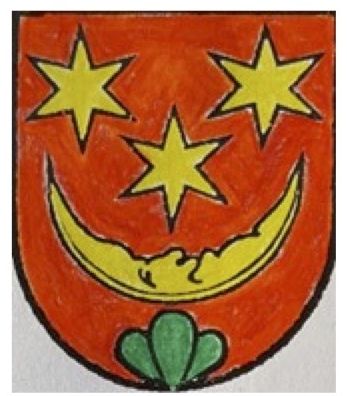
It shows stars above a Dreiberg. My assumption as to why this is so is based on Rolf Kälin's explanations: the freelance heraldist and designer of coats of arms explains on his homepage that the coat of arms of the Middle Ages is a coat of arms that speaks for itself. Three mirrors shown above a Dreiberg stand for the family name Spiegelberg. Thinking analogously: The red castle in Rothenburg's coat of arms is the speaking sign for the place of this name: Burg-Rot or Rothenburg. The stars and the moon, the celestial bodies stand for Stirne or Sterne, and the "man in the moon" is added to the Suhr coat of arms for Stirnemann. Seen in this way, the stars are not just decoration and donators of the 17th century coat of arms hardly had knowledge of the origin of the name, as the origin of a landscape term, the "Stirne" and the place name "Stirnrüti", .
See: Rolf Kälin: https://heraldik-schweiz.ch
Preliminary remarks on the coats of arms shown
The illustrations presented here, which I received from the archives, are the digitally read archive sheets. They also show us a piece of archival history, as all of these sheets were made, drawn, painted, and inscribed by hand in the state archives. In more recent times, a mechanical typewriter was used. The colors of the coat of arms were often only described or applied by hand: with colored pencils or gouache paints. Most of the time, however, these colors no longer shine: the change in the paper and the aging process affected them through darkening. Ralf Kälin: https://heraldik-schweiz.ch
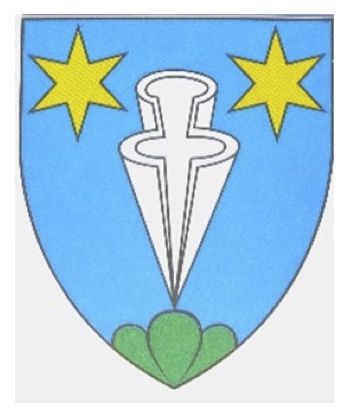
Coat of Arms of the Stirnemann
Let's look at the Stirnemann family first. The line of the Stirnemanns in the canton of Aargau has four different coats of arms depending on the municipality of origin:
Gränichen, Buchs, Kirchleerau and Suhr.
The line of the Gränichen family has been the main coat of arms since 1974 (above). The ploughshare is resplendent above the Dreiberg, accompanied by a star on the left and right. This coat of arms is derived from the representation of the following archive map, which documents a coat of arms of a Stirnemann, who was governor and sub-vogt around 1660.
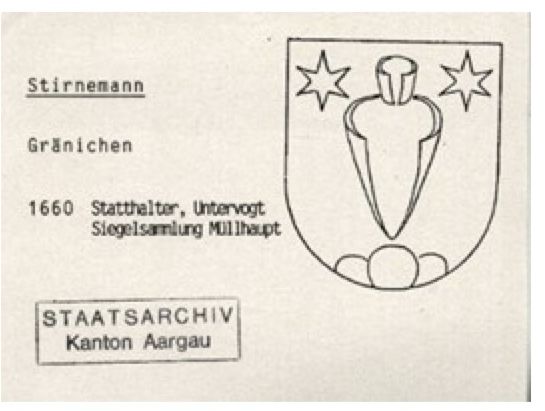
But even in Gränichen there are other representations. Coats of arms can be created freely in Switzerland and you can register and deposit them in the collections of the state archives. The coat of arms of the family Max Stirnemann, authorized signatory, from Gränichen (dated 1972) shows such a variation. In his design, he copied the Suhr coat of arms onto the blue background of the Gränichen coat of arms. Perhaps he came to Gränichen from Suhr?
(Source: State Archive Canton Aarau)
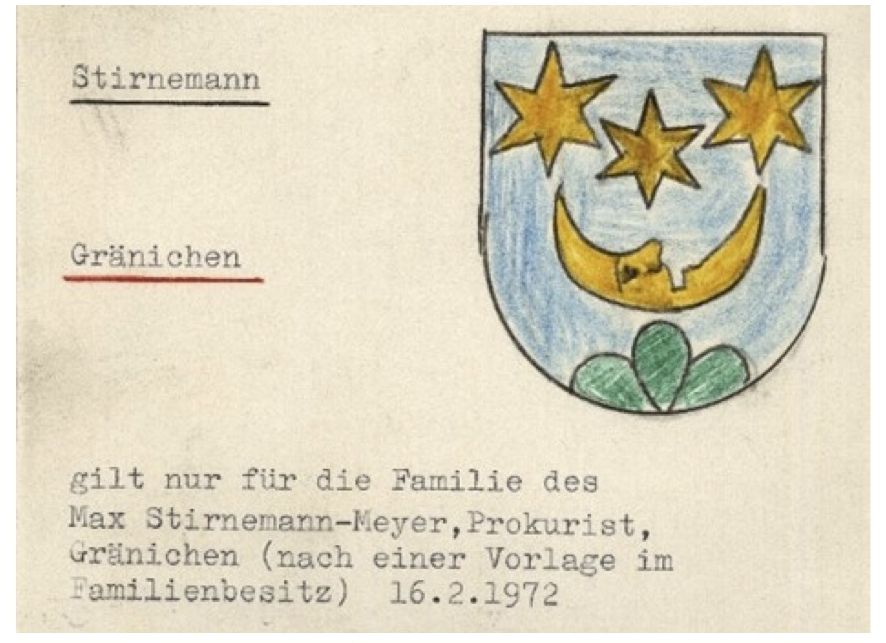
The coat of arms of the Buchs family is essentially an inversion of the coat of arms of Gränichen. The background is now all white, the ploughshare in blue. Exactly when it came about remains an open question. The card from the state archive only says: After the Stirnemann from Gränichen, 1968.
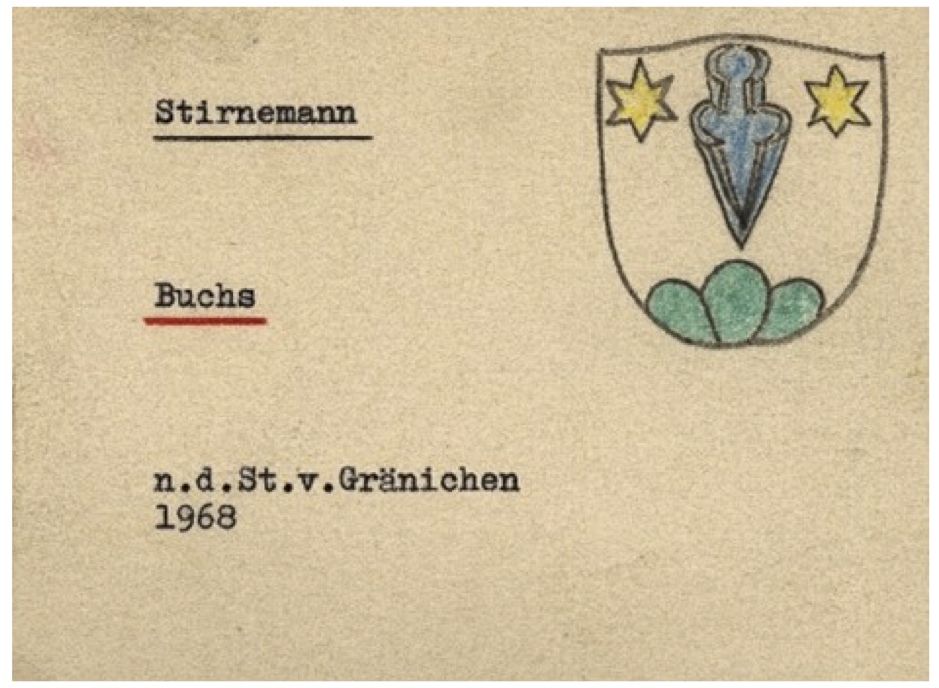
(Source: State Archive Canton Aarau)
The Kirchleerau branch of the family carries a coat of arms that is similar in color to the Gränichen branch. A white cross is shown against a blue background with a crescent moon and a star. The hand note on the card states the year 1949, in the text: "derived from the coat of arms of the Stirnemann from Gränichen 1852". What the text forgets: The crescent moon (“obsigend” by the way) comes from the Surer coat of arms.
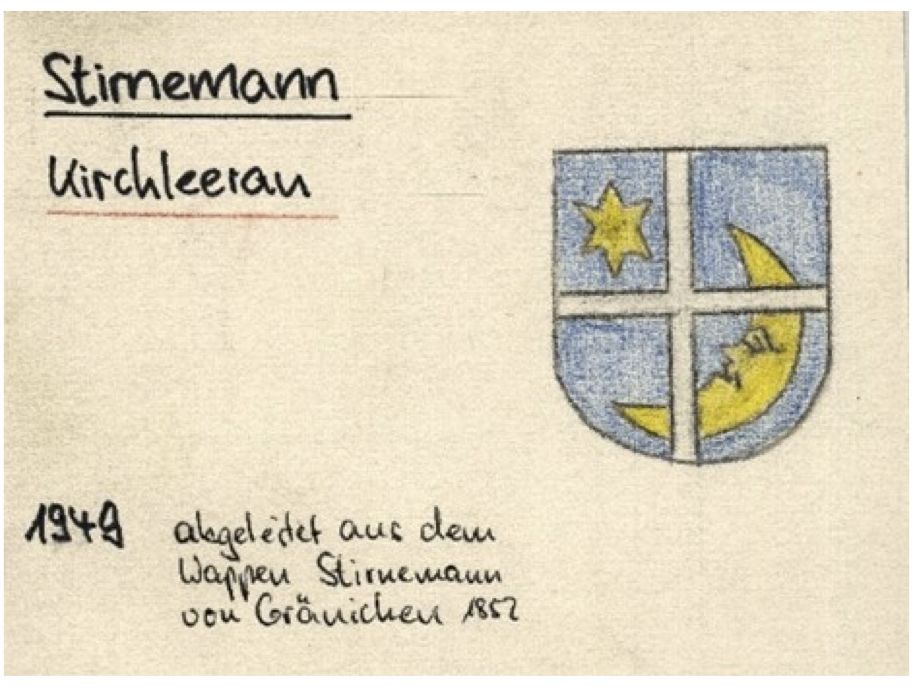
(Source: State Archive Canton Aarau)
The coat of arms of the Suhr Stirnemanns, which we have already mentioned at the beginning, shows another coat of arms variant of the Stirnemann branch with the Dreiberg and the crescent moon lying on it and the three stars. I have to leave it open here how the red background came about. Its bearer was a “Stirnenmann, Jochem, (member) of the court in Suhr. Judgment Disc of 1612”. It is probably the oldest coat of arms of the Stirnemann branch.
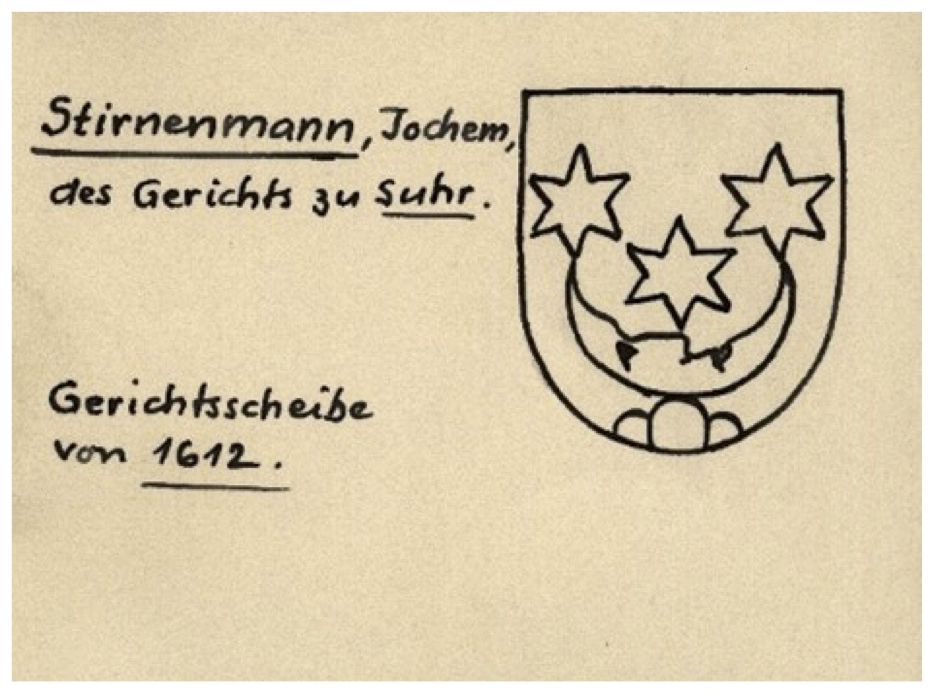
Coat of Arms of the Emigrants
In Berlin, Georges Stirnemann, our research member from Colmar, found the coat of arms of a Stirnemann family that emigrated to Brandenburg around 1692. He found this coat of arms on the marriage document of Ida Stirnemann, who married Julius Schubart on December 28, 1844.
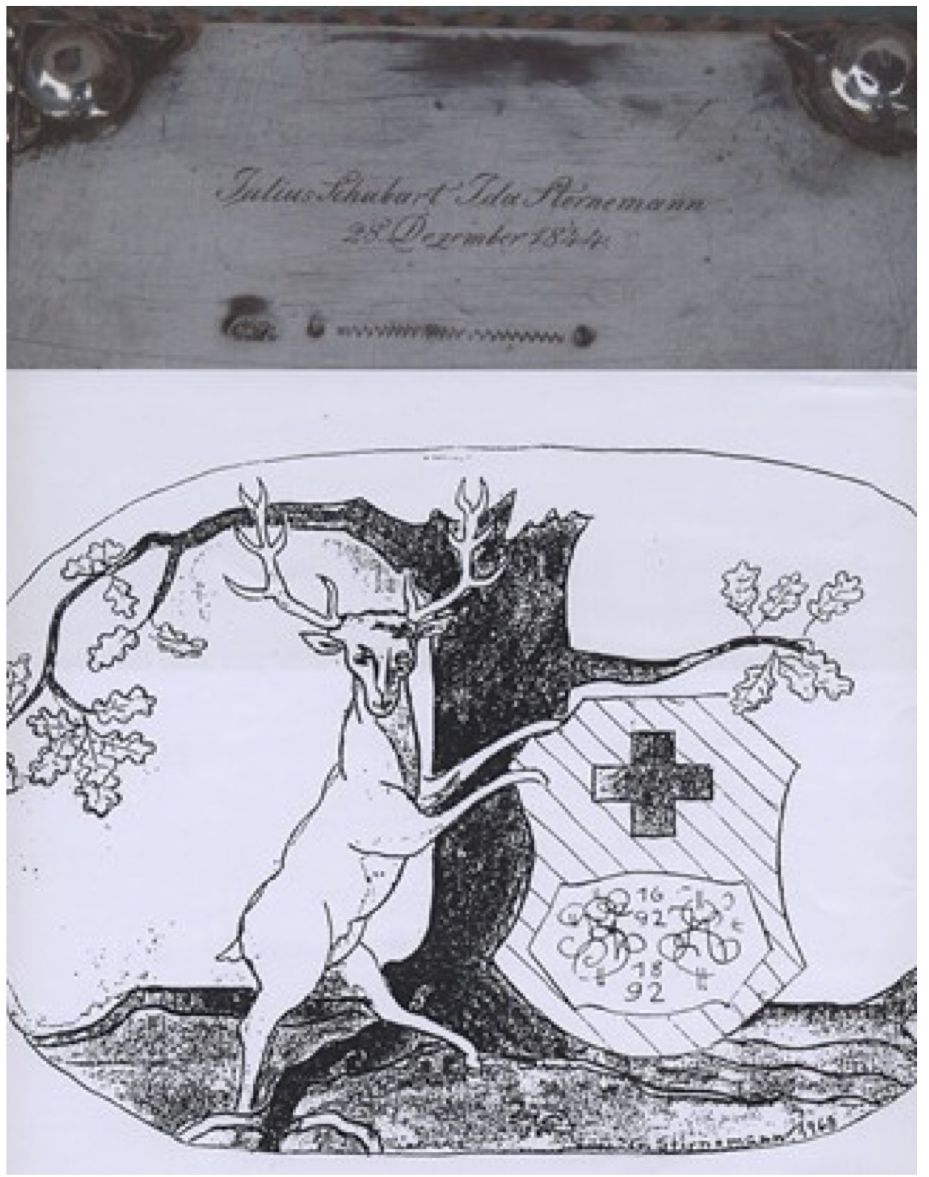
The following depiction shows the colored coat of arms painted on wood.
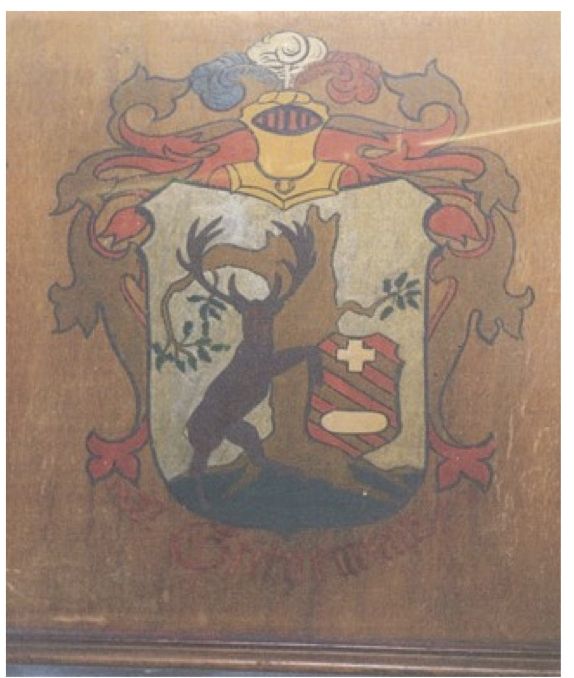
The Coat of Arms is significant in that it tells us a whole story. The white and black background represents the Prussian colors; the desecrated tree, Brandenburg afflicted and depopulated by war and misery. It's still alive, the oak tree still has leaves! The deer is the symbol of new beginnings, of will and strength. - Will and strength of who? The stag points to the coat of arms with its front leg, to the white cross on a red-brown background. Red for Switzerland, where everything was left behind, brown for the new homeland, the land of hope to which courageous Aargau people emigrated in 1692.
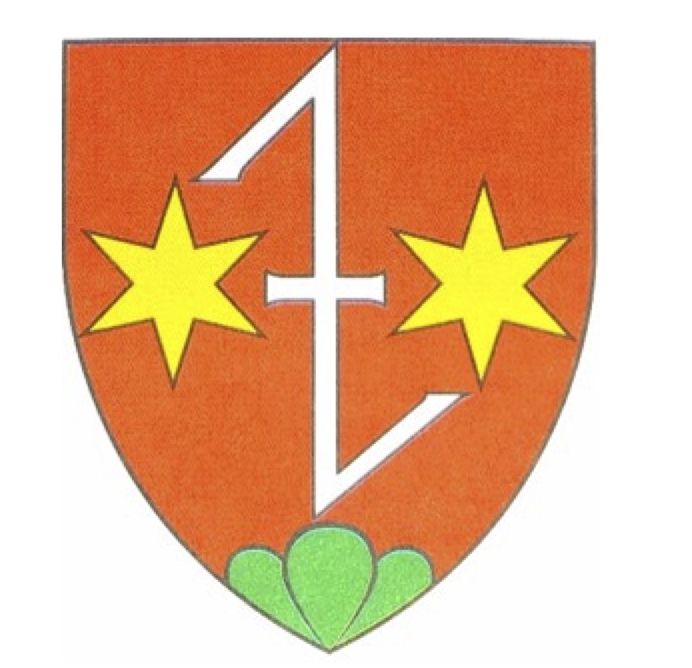
Coat of Arms of the Stirnimann
According to our professor, the coat of arms of the association goes back to Jakob Stirnimann, who lived from 1598 to 1670. In this context, he mentions the purchase letter that the brothers issued to their brother Peter (order name Jodocus, Jost) when he entered the Benedictine abbey in Muri in 1673 has been recorded. On this purchase letter, the sons of Jacob use their father's coat of arms.
The coat of arms of the abbot of Muri, Plaucidus von Klingenberg, from 1694 shows the coat of arms of Jodok with a golden house mark above the Dreiberg on a blue background, but without stars.
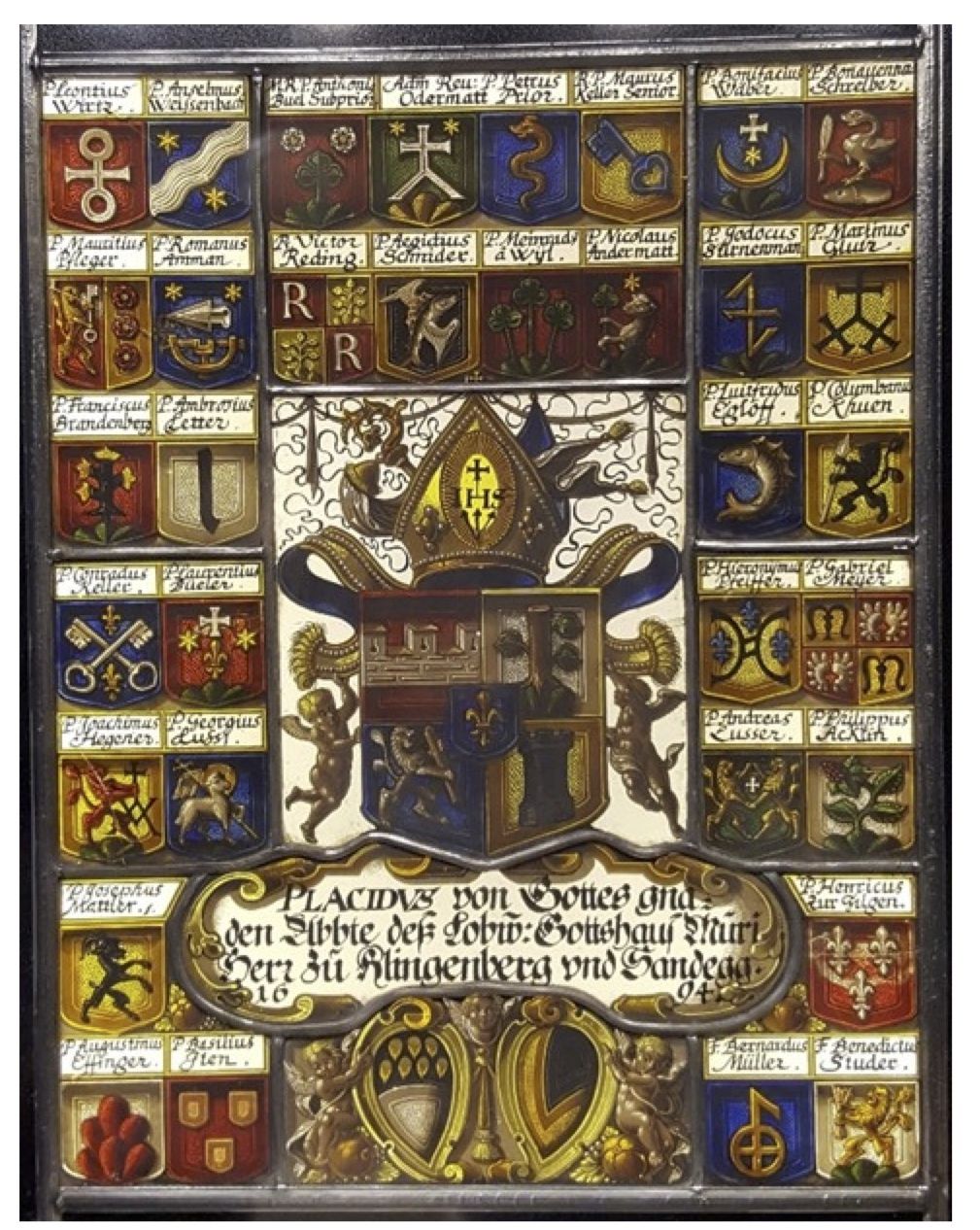
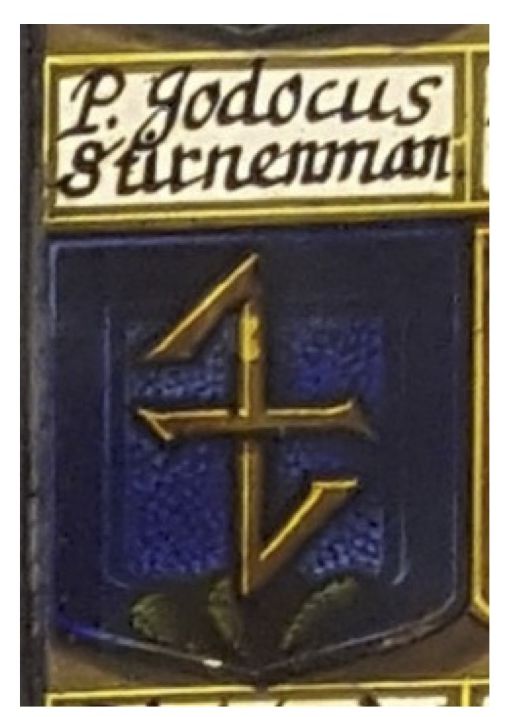
Jodok's Stirnenman's coat of arms without stars is a first variant of the Stirnimann coat of arms.
The coat of arms of Johann Stirnimann, rifle master, Ruswil is attested around 1700. The house brand above the Dreiberg is twisted, three stars adorn the brand. The background is red. The attribution of the State Archives names the family branch “Dorf” as the bearer.
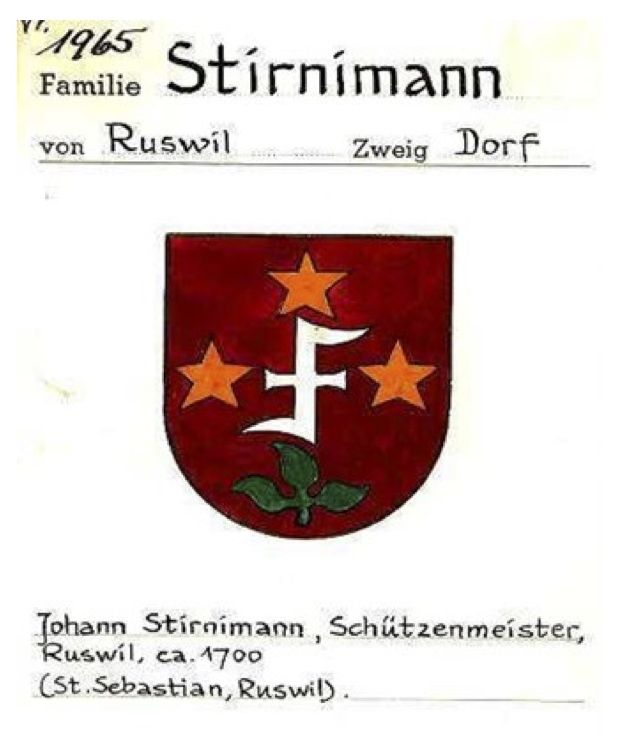
The coat of arms of the “Etzenerlen” branch of the family, dated 1747, also appears with a red background. Peter Stirnimann in the Rot, Marksman, Ruswil, is named as the porter. The black house mark is adorned with four silver/white stars. The Dreiberg is missing.
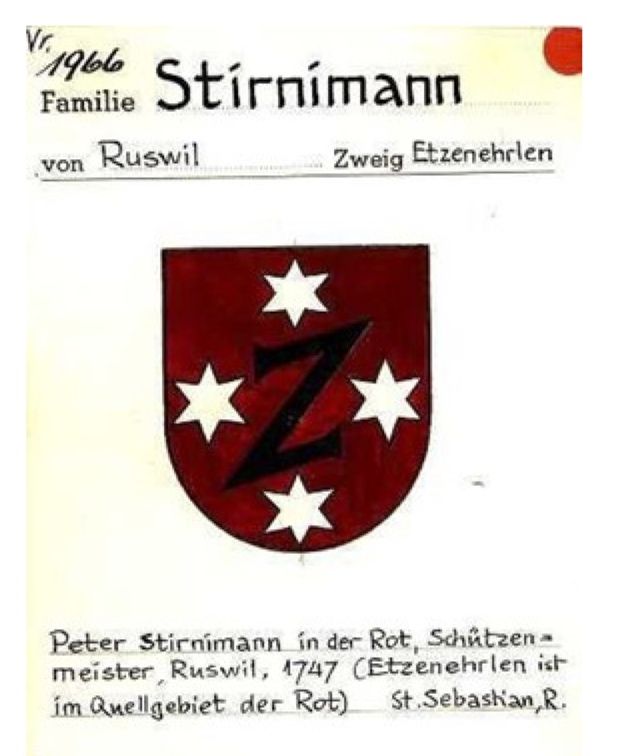
The coat of arms of the Stirnimann branch from Rothenburg and Neuenkirch dates back to 1692. It is a very simple coat of arms with the house mark and two stars on a red background. The Dreiberg was omitted.
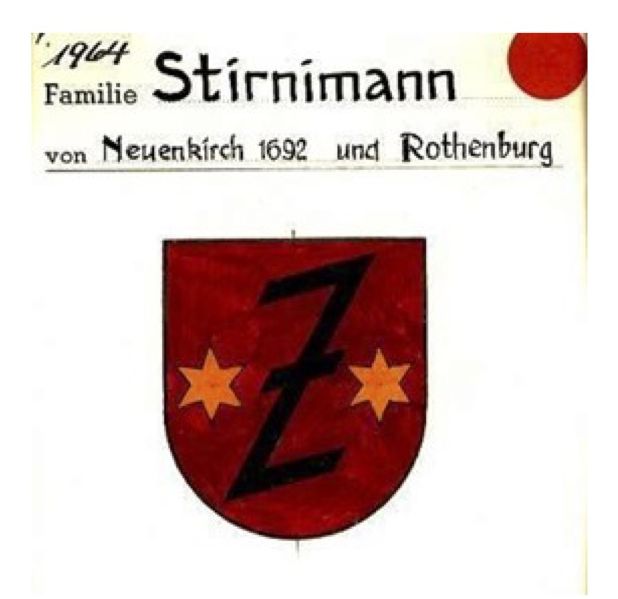
The Stirnimann of the Rüediswil branch wear the same coat of arms in different colors. Again, a Peter Stirnimann is named as the bearer, this time with the designation of origin “from the Rot”. Whether it is the same Peter, especially since the year 1747 is identical, I cannot say here.
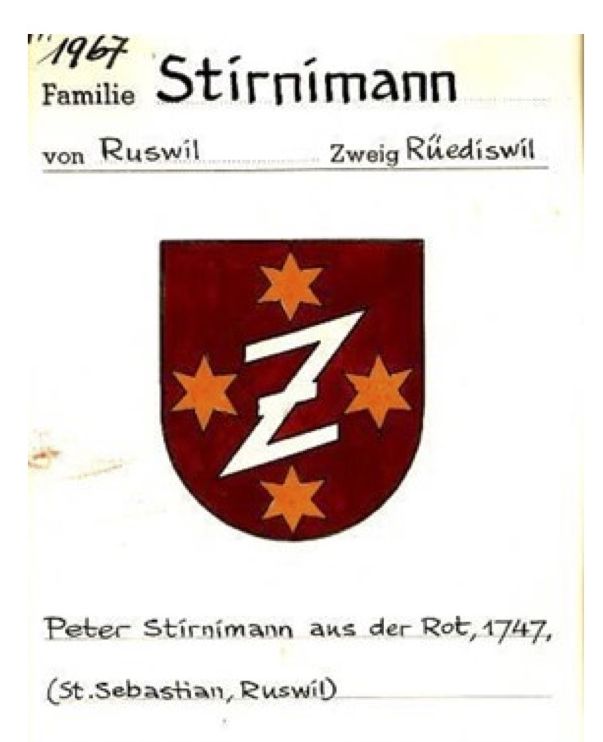
The Stirnimann families from Lucerne and the "old office of Rothenburg" (Rothenburg, Emmen and the Seetal) use the same representation in a different color variant. White background, red stars.
(Source Stirnimann: State Archives of the Canton of Lucerne)
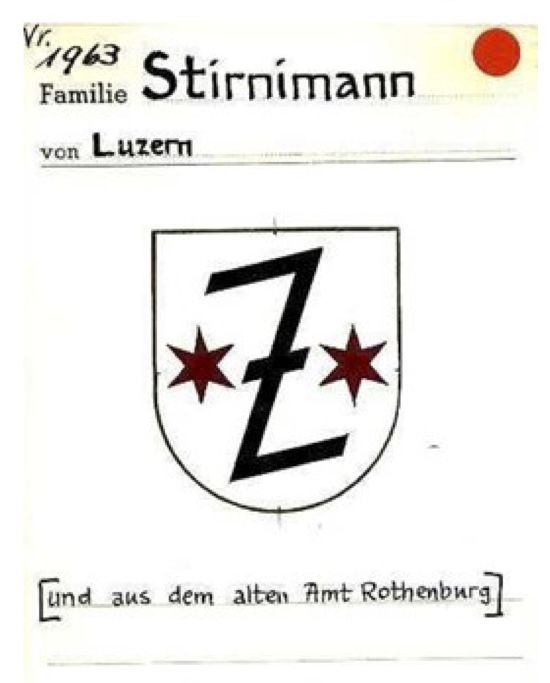
The Stirnimann of the second Nottwil branch turned the Z-shaped house brand so that an S is formed. The background of the coat of arms is red, the house mark and the star are in white over the green trio. The attribution of the State Archives refers to a "donation" in 1925 by an Otto Stirnimann from Basel.
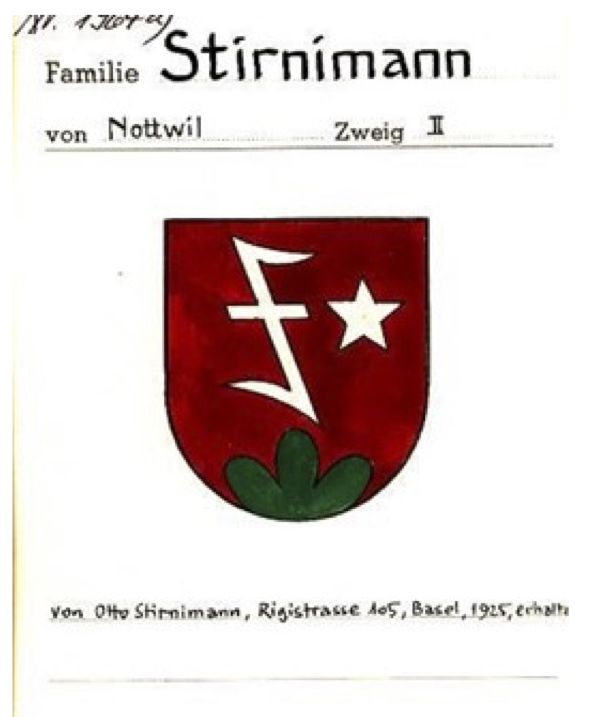
The Sigigen branch of the family goes its own way. The coat of arms, which wants to be attested to 1712, names a J. Stirnimann, Ruswil, as the bearer. In the center it shows the black house mark (in the shape of an S with a crossbar) on a red background, with the green Dreiberg below it.
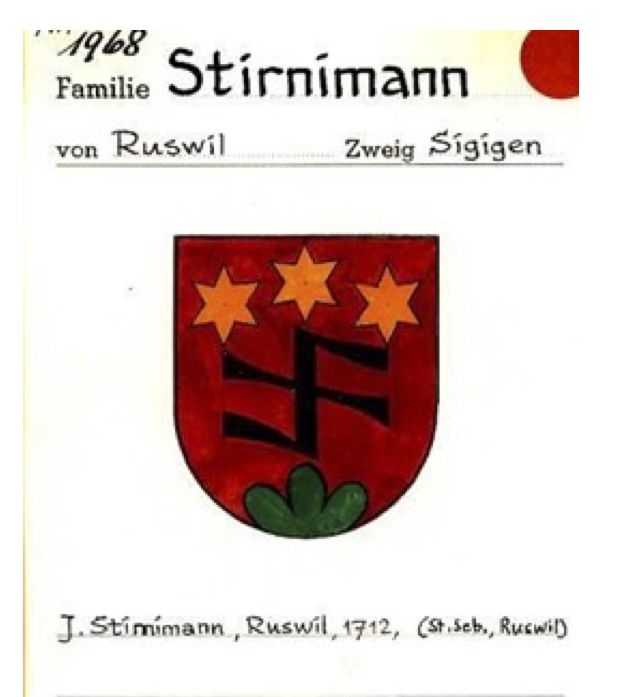
The Stirnimann from the Surental and Hinterland have their own coat of arms. The basic color of all three coats of arms is blue. Arrangement, form and number of the stars is identical. Only the color of the stars varies between white/silver and yellow/gold, possibly red? The coat of arms of 1974 represents a compromise which was found by Prof. Stirnimann and which he finds documented in 1884. In my interpretation, the large circular disc represents a full moon. Three stars shine over the house brand makes sense insofar as the moon, the phases of the moon, played an important role in rural life. When sowing, cutting wood, etc.
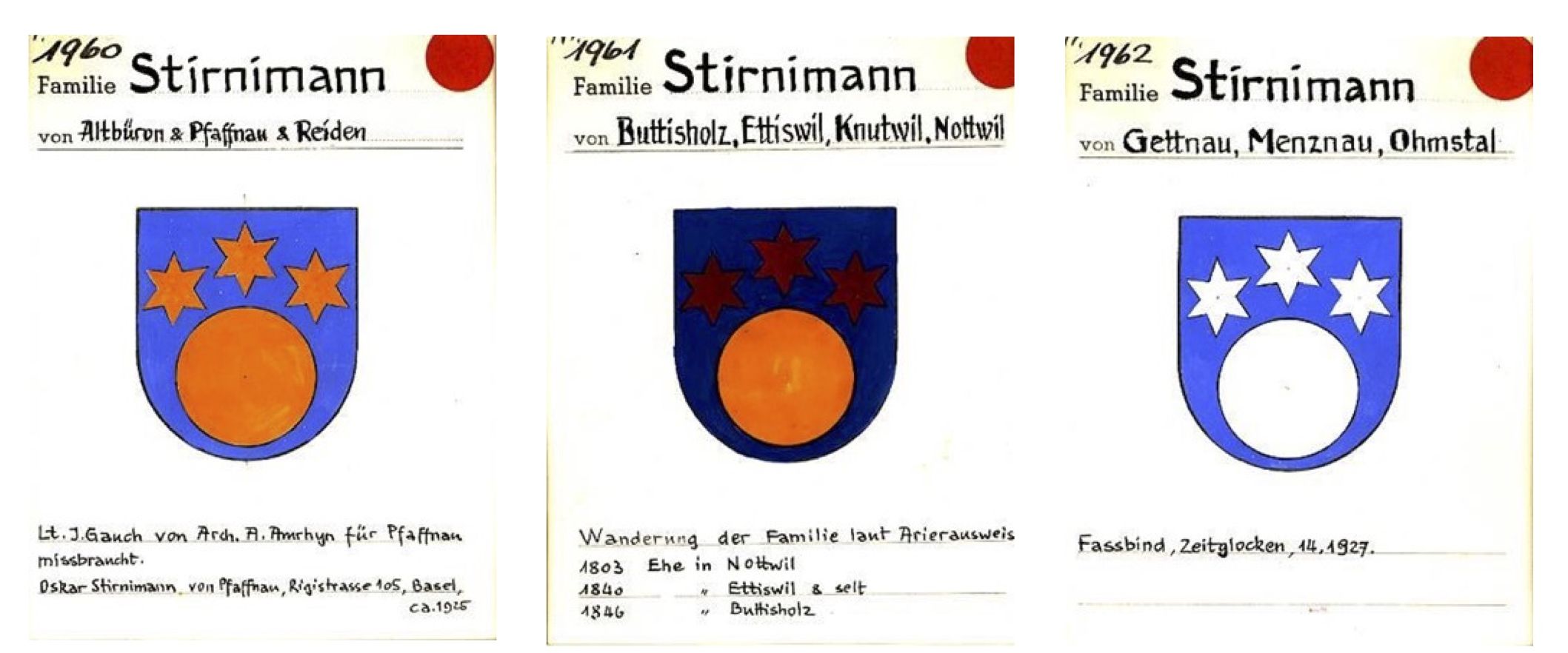
Author: Moritz Stirnimann
Portrait archive thanks to “Leidhelgeli”
Ten years ago, the Central Swiss Society for Family Research (ZGF) launched a project that pursues two ideas: The "Portrait Archive" wants to preserve the memory of the deceased by saving their picture from oblivion. At the same time, the platform supports the archiving of important elements for genealogical research with portrait images and genealogical data. The initiator Bernhard Wirz, family researcher and member of the FZS: "The idea behind it is to collect pictures of people and to preserve them for posterity". With an article "Online archive for images of the dead" in the Luzerner Zeitung on October 1, 2012, it was then possible to reach a broader public. The collection now includes more than 320,000 Photos. Most of the portraits recorded come from the cantons of central Switzerland. This is certainly due to the sponsorship by the FZS, but also to the fact that the "Leidhelgeli" were more widespread in the Catholic cantons.
If you have “Leidhelgeli” etc. of people whose mementos you wish to preserve, then this archive offers a way to do so. Visit the website at https://www.portraitarchiv.ch. You can upload the images yourself. If you cannot do this, send the "Hegeli" to the President. Don't forget to include your name and biographical information. If you know them, add names of parents, birthdays and names of siblings.
Our board
President Moritz Stirnimann, Lindenhausstrasse 4, 6005 Lucerne
Assessor Hans Stirnimann-Bächler, Rebstockstrasse 2, 6017 Ruswil
Actuary Heidy Schenker-Stirnimann, Herrenweg 7, 6030 Ebikon
Treasurer, addresses Gregor Stirnimann, Obereyweg 2, 6207 Nottwil
Internet Josef Stirnimann-Tura, Huobstrasse 87b, 6333 Hünenberg See
Chronicle Philomena Bartholdi-Stirnimann, Steinhauserstr. 29, 6300 Zug
Accounting Josef Stirnimann-Ulrich, Brünigstrasse 8, 6020 Emmenbrücke
Auditors Thomas Stirnimann-Häfliger, Eishofrain 3, 6232 Geuensee
Contact
Association of the Stirnimann/Stirnemann families, Moritz Stirnimann, Lindenhausstrasse 4, 6005 Lucerne
Email: info@stirnimann-stirnemann.ch
Enclosed: Payment slip for the 2022 membership fee of CHF 15.00 PostFinance no. 60-23600-0, IBAN CH62 0900 0000 6002 3600 0
Thank you very much for the prompt transfer of your membership fee - you make the work of our cashier a lot easier if you transfer the payment within 30 days, thank you very much!
Edition: 230 copies